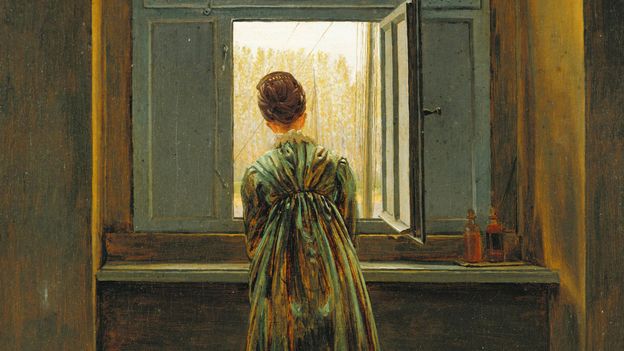The ultimate symbol for our times


These pictorial contrasts, combined with the enigmatic image of a figure with her back turned to us, have meant that the work has elicited multiple interpretations, from connoting religious passage, to expressing confinement and longing. Certainly, the not-unpleasant yearning for another place or time was characteristic of Romanticism, as was the belief in individual expression and subjective emotion. The mastery of Friedrich’s work is that it allows for all these readings. Perhaps most relevant for our current times is that, in its representation of a woman looking through a window to the outside world, this image of pensive quietude also evokes a profound sense of possibility.
Painters of modern life
This feeling of possibility is even more acute in Gustave Caillebotte’s Man on a Balcony, Boulevard Haussmann. Painted in 1880, the view depicted is from the artist’s apartment in Paris, and is representative of the Impressionists’ impulse to portray scenes of contemporary life. Man on a Balcony records the new, modern metropolis following Baron Haussmann’s reconstruction of the old city at the request of Napoleon III. Characteristic of the Haussmann style are the stately, cream-coloured apartment buildings, with their mansard roofs and balconies, which line the boulevard named in honour of the urban planner. The scene’s incredible vibrancy is, in part, achieved by the contrast between these grand facades and the trees’ sparkling greenery. And even though there are no people visible on the street, the work captures the thrill of city life on a beautiful spring day. It recalls, in pictorial form, part of the opening of Virginia Woolf’s Mrs Dalloway (1925):
“And then, thought Clarissa Dalloway, what a morning – fresh as if issued to children on a beach.
What a lark! What a plunge! For so it had always seemed to her, when, with a little squeak of the hinges, which she could hear now, she had burst open the French windows and plunged at Bourton into the open air.”
But Caillebotte’s work doesn’t transport us to Mrs Dalloway’s London, or to her family’s country home in Bourton. Instead, it takes us to the Impressionists’ Paris. Our interlocutor to the city is an urban onlooker, a flâneur, as described by Charles Baudelaire in The Painter of Modern Life (1863). This solitary spectator revels in the bustle of the crowd but remains apart. As does the viewer of Caillebotte’s painting. The open window is our mediator between these private and public spaces, just as the balcony unites its occupant with the wider, modern world.








